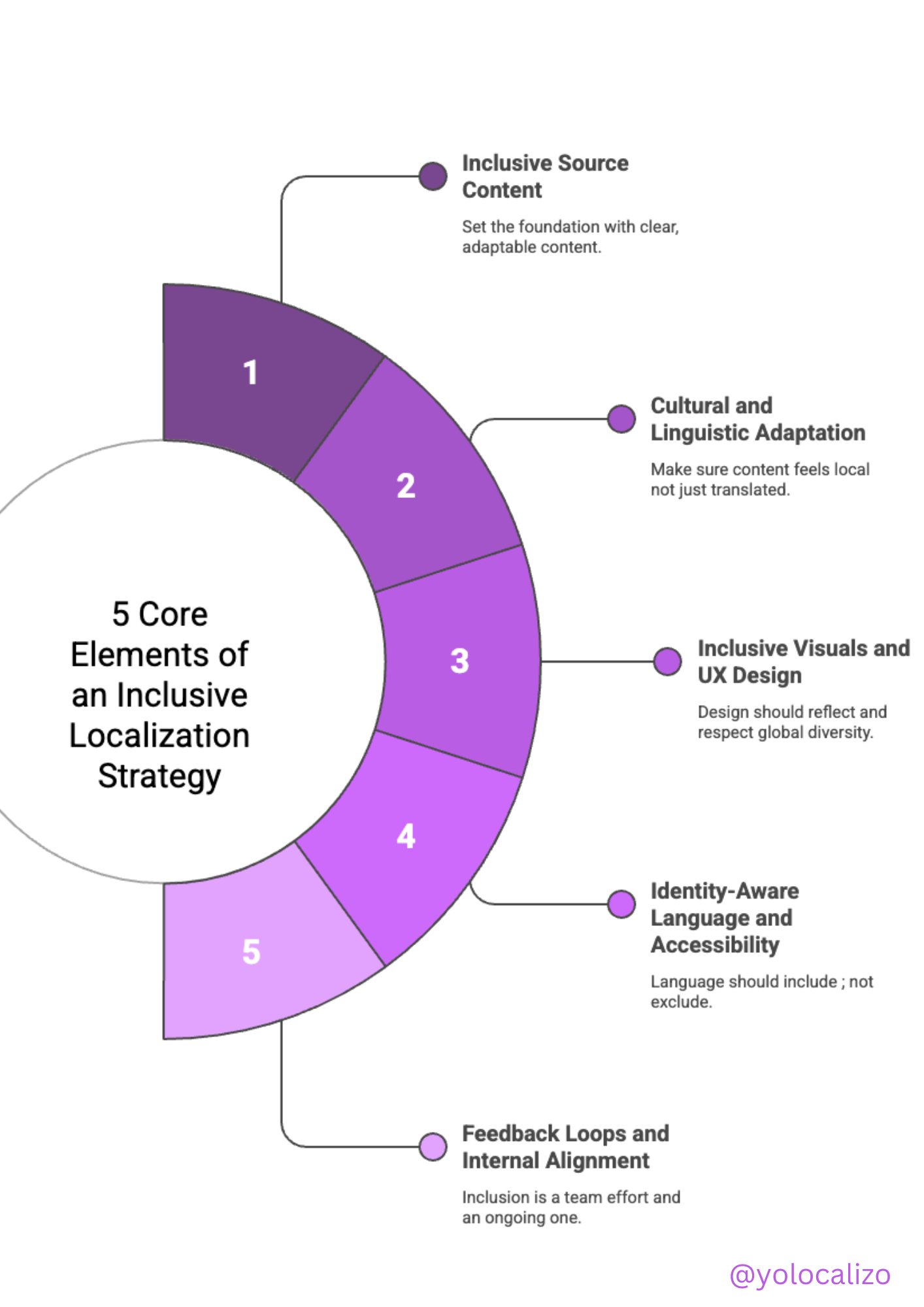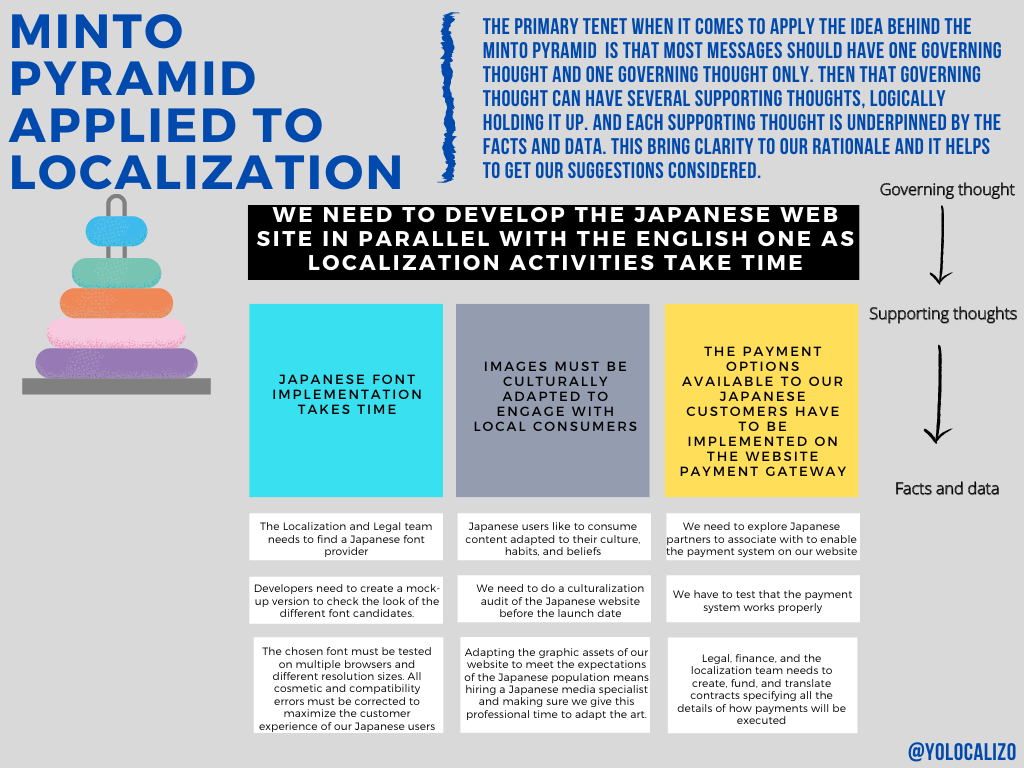Maximise the impact of your Localization ideas by embracing the Minto pyram
Quite often many of the problems we face are related to "communication issues", and I'm sure you've experienced this on more than one occasion.
A deadline in your localization project that has become complicated? Maybe it's a communication problem with the deliverable we were expecting and when we expected it
A TM alignment that we have delegated to a colleague and we are not satisfied with how it has been done? It probably has something to do with how we have communicated the expectations of the task, what it includes, and what is our criteria for assessing that the TM alignment has been done thoroughly, or in a sloppy manner.
A new market that we want to enter with our digital app and stakeholders that do not quite agree with our proposal? It probably has something to do with how we are communicating to our stakeholders the opportunity we have on the table about how that market will add value to the company's bottom line.
The same applies to our personal lives. Many of the conflicts and frustrations we may have with our partners, children, family, friends, etc., often boil down to communication problems. To the gap between what we want to say, and what our interlocutors understand.
There is a podcast that I have been following for years, Manager Tools in which they often say that "Communication is what the listener does"; this means in the context of communication that it does not matter what we as issuers of the message say, what is really important is what our audience, whether it is 1 person, 10 or 100 understand.
That is why I believe that if it is so important for us to express our ideas clearly, then we have to invest time in finding ways and techniques to express those ideas effectively.
A localization team, or a localization industry professional, will invest a very high percentage of their day-to-day work communicating with different parts of the production chain.
Talking to Product Owners to have visibility on the next features that developers are going to implement.
Talking to finance to make sure LSPs' POs have been paid
Talking to the Translators to make sure the translated files will be ready when we need them
Talking to the QA team to make sure they are testing the latest build ... it's all about communication!
And to help you communicate better, and to align expectations, this week in my blog, in this post, I want to talk about one of the most effective communications techniques that I have had the opportunity to study during my professional career.
This technique is tremendously successful in the consulting world and was invented by McKinsey. McKinsey is a consulting firm that has been providing strategic management services to corporations, governments, and other organizations for almost 100 years (founded in 1926 by University of Chicago professor James O. McKinsey)
This framework is one of the most reliable ways to communicate information.
It's also the way big executives talk and think.
At McKinsey, they called it top-down communications or the Minto pyramid (coined by Barbara Minto).
Let me explain in the following paragraphs how to use this communication strategy applied to a practical example in our Localization industry
Principle of Minto's pyramid
This principle bases its effectiveness on the following concept
The primary tenet is that most messages should have one governing thought and one governing thought only. Then that governing thought can have several supporting thoughts, logically holding it up. And each supporting thought is underpinned by the facts and data.
For example, we want to communicate to our stakeholders that localization activities should start as soon as possible, not when the English version is finished but in parallel.
To communicate this message following the principle of Minto's pyramid this is how we should do it
Three levels, starting at the top.
1. Governing thought
This is our main message. It's what really matters, it's our main idea. And if we have several central ideas, then we have to keep thinking, we have to go up a level. We have to keep asking ourselves what my central idea is, what I'm trying to communicate.
For example, we could talk about the launch of our new website in Japan, and the difficulties we face in launching it on time because localization activities are scheduled at a late stage of the development phase. And then we keep talking and talking about localization activities being considered an afterthought... So what?
It seems that what we really want to communicate is "We need to start localizing the Japan site in parallel with English". That's our guiding thought, we want to start Japan's localization activities earlier. The sooner the better, ideally at the same time as English development.
2. Supporting thoughts
Think about the following metaphor to fully understand the difference between governing thoughts and supporting thoughts.
The Governing thought is like the trunk of a tree, while the supporting thoughts are the branches.
Governing thought is the what and supporting thoughts are the why.
Supporting thoughts should be independent of each other, without overlap, and complete enough to make the argument.
When you are shaping your supporting thoughts you should be careful not to immerse yourself in all the facts and data just yet. That is something we will do on the next level.
Example:
(Governing thought)
"We need to develop the Japanese web site in parallel with the English one as localization activities take time"
(Supporting thoughts)
Japanese Font implementation takes time
Images must be culturally adapted to engage with local consumers
The payment options available to our Japanese customers have to be implemented on the website payment gateway
3. Facts and data
It is at this point that we go down to the next level of detail and explain each supporting thought one by one
We continue with the example of the metaphor of our tree ...
If the Governing thought is the trunk and the support thoughts are the branches ... it turns out that the "facts and data" are the leaves and the flowers :)
Example:
"We need to develop the Japanese web site in parallel with the English one as localization activities take time"
Japanese Font implementation takes time
The Localization and Legal team needs to find a Japanese font provider
Developers need to create a mock-up version to check the look of the different font candidates.
The chosen font must be tested on multiple browsers and different resolution sizes and all cosmetic and compatibility errors must be corrected to maximize the customer experience of our Japanese users.
2. Images must be culturally adapted to engage with local consumers
Japanese users like to consume content adapted to their culture, habits, and beliefs
We need to do a culturalization audit of the Japanese website before the launch date
Adapting the graphic assets of our website to meet the expectations of the Japanese population means hiring a Japanese media specialist and making sure we give this professional time to adapt the art.
3. The payment options available to our Japanese customers have to be implemented on the website payment gateway
We need to explore Japanese partners to associate with to facilitate the payment system on our website
We have to test that the payment system works properly
Legal, finance, and the localization team needs to create, fund, and translate contracts specifying all the details of how payments will be executed
The top-down approach of a single message with supporting thoughts and facts is extremely useful because it is very clear, easy to digest, and gets to the point
Click HERE to download the infographic
When we are explaining why it might be a bad idea to start localization activities after the English version is finished, then complexity can get in the way.
We may start complaining bitterly that Localization cannot be considered an afterthought. We might complicate even more our rationale with statements such as the dangers of having hardcoded English text on the Japanese version of our site, or the dangers of concatenating variables, or the need for Unicode to be supported ...
If we start with a bottom-up approach of stating facts and data first, the audience is confused (and quite often bored as they do not follow our reasons)
But if we turn the pyramid around and start with the main idea and then nest these points under one guiding thought to make clear what really matters, then we are in a much better position to succeed with our communication strategy
I have read that this communication strategy is used very often at McKinsey, and that part of McKinsey's success is attributed to the fact that their executives have internalized this way of communicating and thinking when they coach their clients. In fact, the idea is so powerful that even Barbara Minto, who is considered the mother of this strategy, wrote a book where she outlines this very effective communication principle
The Principle of the Pyramid: Logic in Writing and Thought 3rd Edition
Now it's your turn
What do you think? Do you see the value of this communication technique?
Will you include this communication strategy in your localization toolbox?
Practice the Minto pyramid in every localization initiative you propose and you will be surprised by the results.
This technique clarifies your thinking process (and improve your communication skills)
Good luck, and let me know how it goes.
@yolocalizo















Localizability has always been a challenge small issues in source content often lead to big problems later in translation. In this post, I explore how AI is giving localization teams a powerful new way to improve source quality, reduce friction, and create better content for every market right from the start.